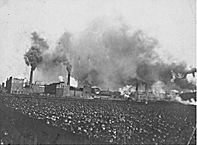| Entries |
| A |
|
Air Quality
|

|
In 1959 the city created the Department of Air Pollution Control. The new department investigated all types of emissions and suggested regulations for several previously ignored sources of pollution, including burning refuse and leaves. Public concern for air quality heightened after a 1962 disaster killed hundreds of London residents, and by 1964 Chicago received more than six thousand citizen air pollution complaints per year. As with the early movement to control smoke, the new activism focused on the potential negative health effects of impure air. Not surprisingly, the Loop, the Calumet Region, and northern Lake County, Indiana, were the most polluted districts in the metropolitan area.
In 1967 the U.S. Public Health Service determined that only New York City's air was more polluted than Chicago's. Impelled by citizen activism and new federal regulations in the 1970s, the city attempted to control the largest polluters, including the massive South Works steel plant. Even as these efforts began to reap benefits, however, the continuing suburbanization and auto dependence of the metropolitan area meant that auto emissions would plague the city for decades to come.
By the 1990s, a decline in heavy industry and effective regulation of auto emissions combined to significantly improve Chicago's air. Chicago no longer ranked among the nation's most heavily polluted cities.
The Encyclopedia of Chicago © 2004 The Newberry Library. All Rights Reserved. Portions are copyrighted by other institutions and individuals. Additional information on copyright and permissions.